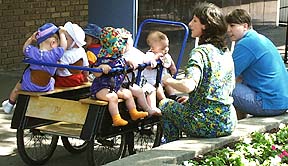One of the most vocal and well-respected spokespersons for downtowns in William Whyte. He has written many articles describing the vitality to be found only in downtowns.
An article in TIME magazine, titled "Contrary to Previous Reports, Cities Are Not Dead," makes important points about the need for a downtown's vitality on its sidewalks.
The future, [Whyte] has been told, is elsewhere: in the suburbs, the country, anywhere but the city. Nonsense, says Whyte. 'The core of the city has held. It has not gone to hell.' What is more, he argues, 'the city remains a magnificent place to do business, and that is part of the rediscovery of the center. While we are losing a lot of functions that we used to enjoy, we are intensifying the most important function of all--a place for coming together.'
...In his latest book, City, Whyte continues to challenge orthodox urban planning. For one thing, he likes free-floating city congestion... He advocates narrower streets for cars and wider sidewalks for people... Cram as many stores as possible along the streets to bring them alive. Do away with skywalks, abolish sunken plazas and tear down walls in front of parks and playgrounds, because they all increase isolation from the city experience.
"Whyte puts his faith in something he calls 'the impulse of the center,' which animates his vision of the teeming urban core. 'You see it at cocktail parties,' he says, 'the phenomenon where people move toward the center. It is an instinct to be in a position of maximum choice.'
 To Whyte, volume is life. That is why he is convinced that the street corner remains the best meeting place in the world: 'What you want to do is maximize street activity,' he continues. 'Your life is on the street. A lively street has many entrances and exits. It's like a stage set. This is one of the reasons why there shouldn't be blank walls. Stores need all the competition they can get. '
To Whyte, volume is life. That is why he is convinced that the street corner remains the best meeting place in the world: 'What you want to do is maximize street activity,' he continues. 'Your life is on the street. A lively street has many entrances and exits. It's like a stage set. This is one of the reasons why there shouldn't be blank walls. Stores need all the competition they can get. '
Smaller cities in general, he argues, are more vulnerable than larger ones to competition from nearby shopping malls. 'I heard James Rouse, the urban developer, lecture in Dallas on this. He said, 'You are copying the physical form of my malls. You shouldn't be doing that because the malls are not for downtown. What you should be copying is my centralized management, my tenant selection, my outreach.'
Allis, Sam. "Contrary to Previous Reports, Cities Are Not Dead." TIME, August 7, 1989. pp. 9-10.
Whyte's belief in the importance of the downtown is amplified further in an article for Historic Preservation magazine, where he discusses the street as the lifeblood of the city.
The street--particularly in the center city--is among the greatest of our cultural legacies. It is the river of city life. It gives the city continuity and coherence. It defines its scale. But it is under attack.
The condition is not a novel one; the post World War II period also was a bad one for cities. The federal subsidization of suburban development helped achieve the ruination of the countryside with a building pattern that used 10 acres to do the work of one. Even more devastating were the effects of these programs on the city. The freeways not only physically drew out people, business and shopping; they did more than urban renewal to destroy the fabric of the center city.
...people tend to sit where there are places to sit. But what is just as important as a good place to sit is what you see from. The prime places are those with full views of the main show, the street.
Successful spaces are not cut off from the street; they are not elevated above it, nor are they sunk down beneath it. Sunken plazas are usually empty.
The elements of a good city space, then, are basics, and it is interesting to note how many of them are natural--people to watch, sun to bask in, trees to sit under, water to splash in and listen to. Nowhere does nature seem so important to people as in the city, and enjoyment of the city outdoors is increasing.
...The city is reaffirming its great and most basic function as a place for people to come together. This is the street: busy, noisy, crowded, tacky, but full of life and vitality. And full of continuity--the sense of where we are and where we've come from. There's our future.
Whyte, William H. "The Humble Street." Historic Preservation. January, 1980. pp. 34-41.
 To Whyte, volume is life. That is why he is convinced that the street corner remains the best meeting place in the world: 'What you want to do is maximize street activity,' he continues. 'Your life is on the street. A lively street has many entrances and exits. It's like a stage set. This is one of the reasons why there shouldn't be blank walls. Stores need all the competition they can get. '
To Whyte, volume is life. That is why he is convinced that the street corner remains the best meeting place in the world: 'What you want to do is maximize street activity,' he continues. 'Your life is on the street. A lively street has many entrances and exits. It's like a stage set. This is one of the reasons why there shouldn't be blank walls. Stores need all the competition they can get. '
